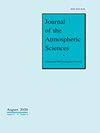非绝热效应对SACZ事件演化能量产生的影响:来自洛伦兹能量循环的视角
IF 2.8
3区 地球科学
Q2 METEOROLOGY & ATMOSPHERIC SCIENCES
引用次数: 0
摘要
在这里,我们使用ERA-5再分析的气象数据集来研究2013年12月12日至26日发生的SACZ事件的动力学和热力学特征。这是一次非典型的SACZ事件,云带位置和降雨量变化很大,给社会带来了巨大的问题。我们通过洛伦兹能量循环(LEC)研究了这一情况,主要关注非绝热加热在能量产生和循环方面的作用,从三个阶段(形成、发展和耗散)分析了这一事件,并根据对流局域化模式对其进行了讨论。非绝热热速率对热带地区24°S以南和900 hPa以下中层SACZ事件的能量产生有很大影响。在LEC中,SACZ区域的发电项在开始(12月12日至15日)较大,在结束(12月23日至26日)较小,平均值分别为21.23和-7.62 W/m2。转换项遵循LEC方向,除了在整个分析期间占主导地位的正压不稳定性[C(KE,KM)<0]。12月16日至22日期间,对流区向北扩展,反映为热带地区最强烈的加热和较弱的正压不稳定。摩擦项不利于事件衰减;因此,我们得出结论,通过Q和T之间的负协方差进行冷却有助于事件衰减。我们发现,这些结果在很大程度上受到中纬度波列配置的影响,该配置有利于事件的持续、扩展和衰减。本文章由计算机程序翻译,如有差异,请以英文原文为准。
Diabatic Heat Effects on the Generation of Energy for Evolution of a SACZ Event: A Perspective from the Lorenz Energy Cycle
Here we used meteorological data sets from ERA-5 reanalysis to study the dynamic and thermodynamic characteristics of a SACZ event that occurred between December 12 and 26, 2013. This is an atypical SACZ episode with considerable variations in cloudiness band positioning and high rainfall amounts, causing enormous problems for society. We study this case through the Lorenz Energy Cycle (LEC), focusing mainly on the role of diabatic heating in energy generation and consequently in circulation aspects, analyzing the event in three stages (formation, development, and dissipation), and discussing it according to the convection localization pattern. The diabatic heat rate has a large impact on the energy generation of SACZ events at midlevels south of 24°S and below 900 hPa in the tropics. In LEC, the generation terms in the SACZ area were larger at the beginning (December 12-15) and smaller at the ending periods (December 23-26), with means of 21.23 and −7.62 W/m2, respectively. The conversion terms follow the LEC directions, except for barotropic instability [C(KE,KM)<0] that dominates throughout the analyzed periods. The convection area expansion to the north between December 16-22, was reflected by the most intense heating in the tropics and weaker barotropic instability. The friction term did not favor the event decay; therefore, we concluded that the cooling through a negative covariance between Q and T contributed to the event decay. We find that these results were largely influenced by a midlatitude wave train configuration that acted to favor the persistence, expansion, and decay of the event.
求助全文
通过发布文献求助,成功后即可免费获取论文全文。
去求助
来源期刊

Journal of the Atmospheric Sciences
地学-气象与大气科学
CiteScore
0.20
自引率
22.60%
发文量
196
审稿时长
3-6 weeks
期刊介绍:
The Journal of the Atmospheric Sciences (JAS) publishes basic research related to the physics, dynamics, and chemistry of the atmosphere of Earth and other planets, with emphasis on the quantitative and deductive aspects of the subject.
The links provide detailed information for readers, authors, reviewers, and those who wish to submit a manuscript for consideration.
 求助内容:
求助内容: 应助结果提醒方式:
应助结果提醒方式:


